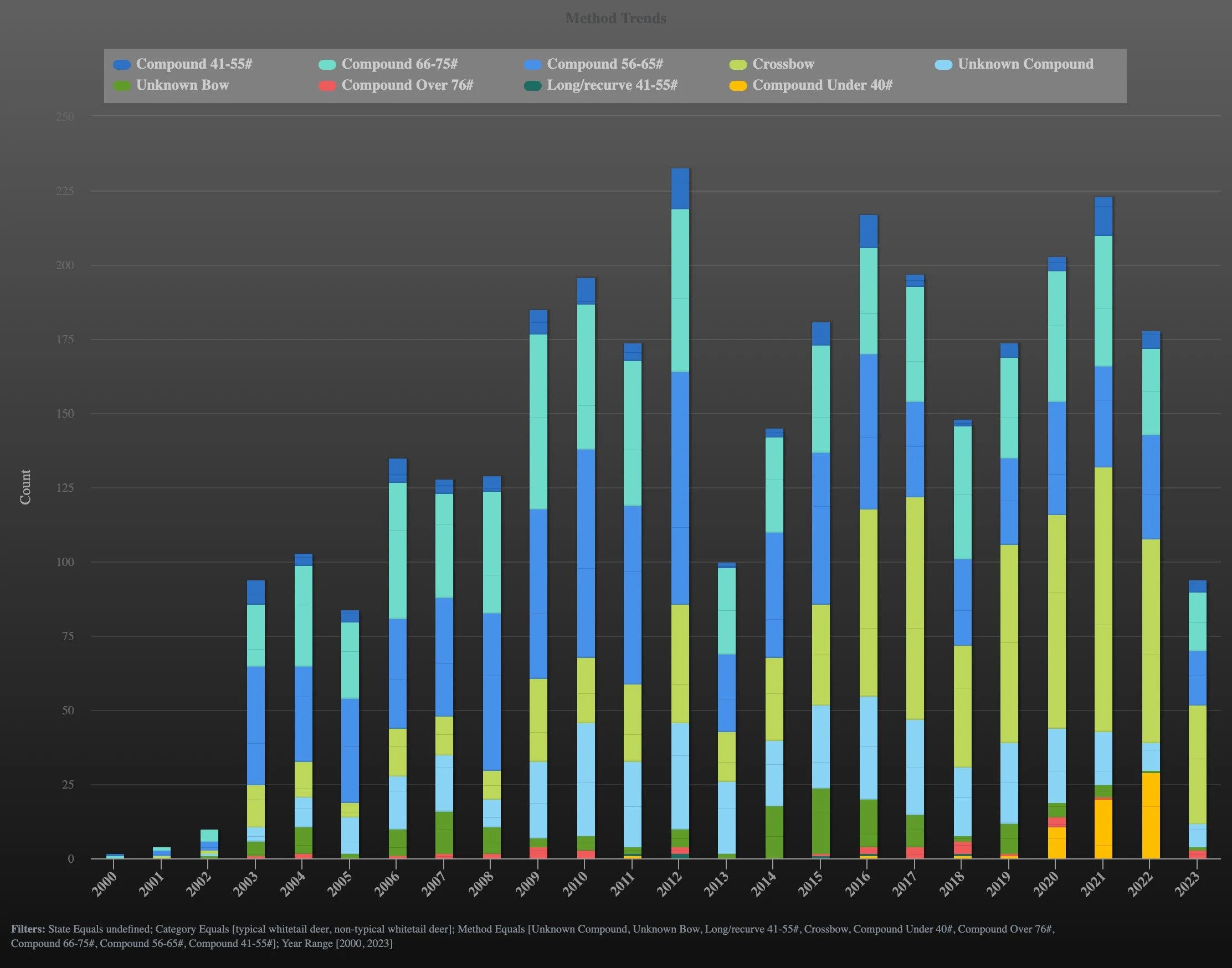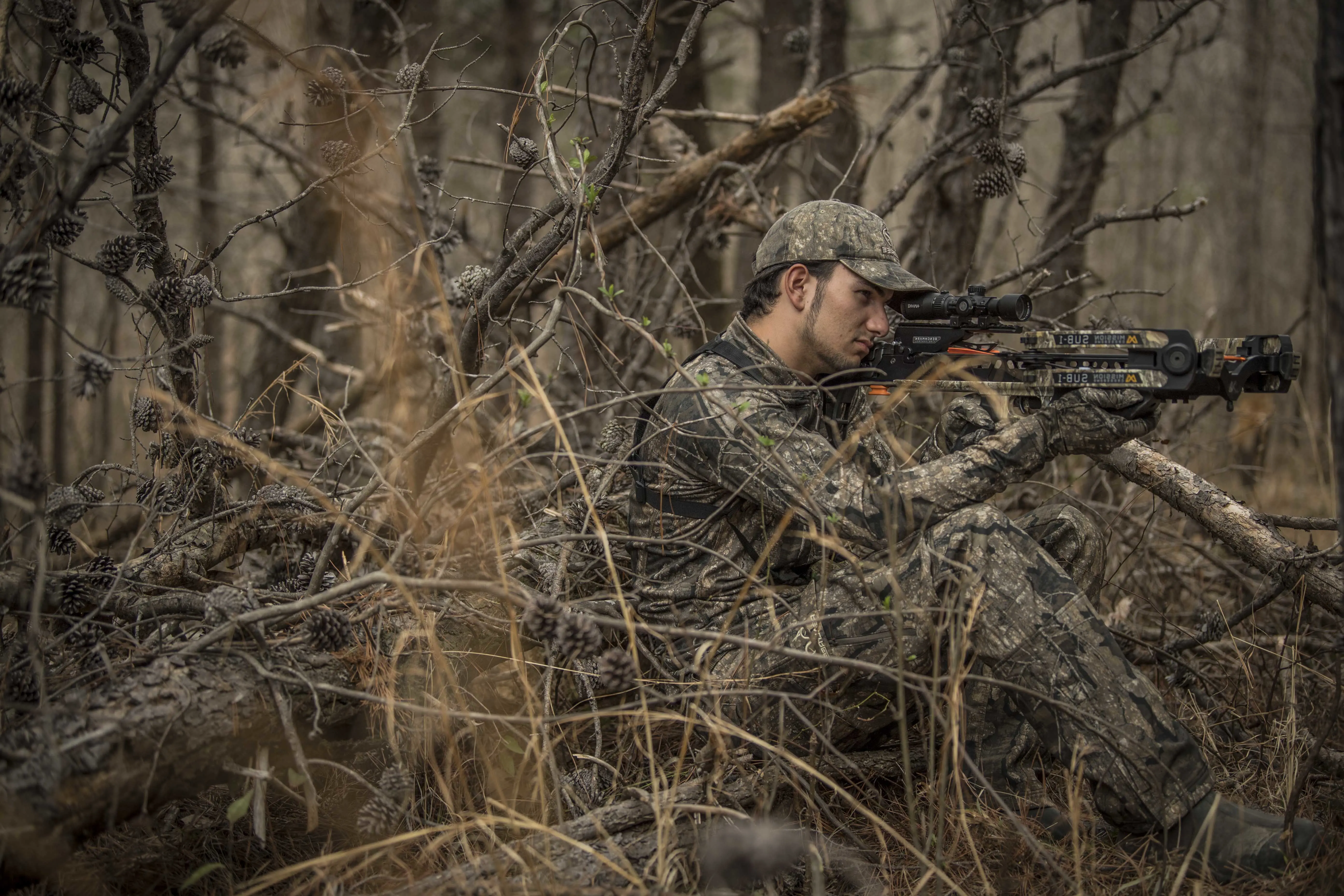The debate about crossbows being allowed during bow seasons is pretty much over. Sure, a few vertical-bow purists emerge each fall to lambast able-bodied hunters who dare to hunt with crossbows. And a few hunters—myself included—still find occasion to point out the obvious fact that crossbows are easier to use and deadlier than vertical bows. But for the most part, x-bows are now accepted as standard archery equipment. Not only that but harvest trends from numerous states and the Boone and Crockett Club record books suggest that crossbows are well on their way to becoming even more popular than compound bows—which would be a major shift in archery-tackle preferences.
I’ve been spending time recently analyzing B&C's Big Game Records Live, which is a subscription-based service that allows you to view data on the thousands of trophy animals entered into the B&C record books over the years. One of the coolest tools in that service is the Method Visualizer, which sorts the weapons that are used most often to take record-book game animals. B&C has been tracking this method data for about 50 years and storing it digitally for the past 23, so the results displayed begin in 2000 (though the samples are very small for the first few years).
Bowhunters have definitely put their share of big whitetails into the record books. In fact, of the roughly 6,000 record entries since 2000, 2,172 of them were taken with a compound bow, traditional bow, or crossbow. That’s no big surprise, since bow seasons are long and open during the most productive hunting times, like the early season and the peak of the rut.

But things get interesting when you start looking at the 7-year equipment trends beginning in 2003 and comparing the vertical bow entries to the crossbow entries. From 2003 to 2009, vertical bowhunters averaged 45.8 record-book bucks per year. Crossbow hunters averaged just 6.6 in the same timeframe. Back then, many states didn’t allow crossbows during archery season, and the crossbows that were available to hunters were clunkers compared to the models of today.
Things changed a bit from 2010 to 2016. It was an especially productive stretch for bowhunting big deer. Vertical bowhunters averaged 66.8 entries per year during that timeframe, while crossbow hunters averaged 17. But the big shift happened from 2017 to 2023. Vertical bowhunters averaged 50.5 entries per year during that stretch, which was still more per year than crossbow hunters, but a 24% decline from the previous seven years. Crossbow hunters, meanwhile, averaged 33.4 entries per year—a 49% increase over the previous 7-year crossbow tally.
Two big things happened in the crossbow world during this timeframe. Most notably, some 30 states legalized them for most or all of archery season, including all but a handful of states in the Midwest, Southeast, and Northeast. Crossbow technology took a dramatic leap forward, too. Speeds of 400 feet-per-second-plus became standard, as did match-grade triggers, good mechanical cocking devices, and 30mm scopes with good glass and illuminated reticles. One-hundred-yard accuracy became a reality for the everyday user, and a few crossbow companies weren’t shy about advertising it.
Related: Best Crossbows of 2024
Will Crossbows Soon Outnumber Compounds During Bow Season?

Assuming these trends will continue—and there's no reason to think they won't—getting a crossbow might be your best bet for killing a giant whitetail this season and for the foreseeable future. Crossbows are far easier to master than compounds and require far less practice. For the average hunter, they’re more accurate and can double the effective range over a compound bow, too. Allow that capability during archery season, and of course hunters will take advantage of it. Though I still hunt with a vertical bow most of the time myself, I shot one of my biggest whitetails to date last fall with a crossbow. I had his pattern pegged, and the x-bow was the most effective tool available to kill him. I took full advantage of it.
In many states that separate the data (Wisconsin, Pennsylvania, and Michigan are good examples), the crossbow harvest tends to outpace the vertical bow harvest within a few years after crossbows are legalized during archery season. In Ohio, the crossbow harvest is frequently even higher than the firearms harvest. Still, these changes aren’t additions to the total deer harvest as much as they are shifts in the timing of the harvest—and so far, that’s not been a concern for state agencies. And while the shift in preferences for crossbows has become very evident in areas of the Midwest and Northeast, where firearms seasons tend to be during the post-rut and only a few days long, it’s not as prominent in the Southeast, where rifle seasons tend to open earlier and run later.
Crossbow advocates have long touted the tools as being great for hunter recruitment and retention. That was probably the biggest selling point for state agencies to legalize them for archery seasons. While crossbows have no doubt helped bring a few new faces into bowhunting, it’s a safe bet that most of today’s crossbow users are either long-time vertical bowhunters who’ve switched to the more effective, easier-to-use tool, or gun hunters taking advantage of extra time in the woods.
In some ways, these trends are vindication for the many vertical bowhunters who were opposed to crossbow inclusion. Those bowhunters have always warned that the shorter learning curve of a crossbow would ultimately erode the tradition of bowhunting, which requires some athleticism and regular practice to be any good. It would also put more hunters in the woods during a time of year when hunting pressure was traditionally low. Compound bow hunters can complain, but the floodgates are open now. And the shift isn’t unlike the change from recurves to compound bows decades ago. Trad-bow hunters, by the way, have accounted for just 7 bucks in the B&C record books, or about .003% of the archery total.
Related: Best Crossbows for the Money


